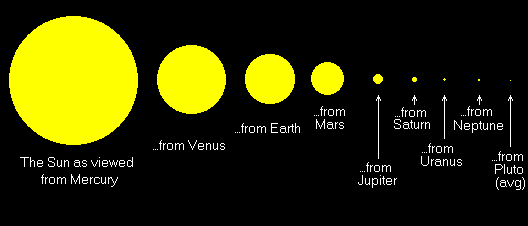
(Or: how much one can get out of drawing circles)
The following figure shows what the Sun’s disk would look like from each of the nine planets. The important thing here is to notice the size of Sun’s disk as seen from Earth (3rd from left), because that is what we are familiar with. We can then compare the other sizes with that, and imagine how big, or small, the Sun would look on the sky of each of the other eight planets.

I should mention here that I used the average distances of each planet from the Sun to do the calculations. The orbits of the planets are not circular, but elliptical. For most planets, their elliptical orbit does not differ too much from a circle to make any difference in the above figure. The exception is Pluto: its perihelion (closest point of orbit to the Sun) brings it closer than Neptune, while its aphelion (farthest point from Sun) carries it so far away that we would need less than a pixel to depict the Sun’s disk.
We will never be able to actually see the Sun from any of the giant planets (Jupiter, Saturn, Uranus, Neptune), because they do not have a solid surface to set our foot on and a transparent atmosphere to gaze at the sky. Many of their satellites, though, offer just such a suitable place: due to their (relative) proximity to the planet they orbit, we should get exactly the corresponding sizes depicted above, if we landed on them.
As an aside, when I was a child I used to create in my mind the image of a huge Sun, covering the better part of the sky, rising over Mercury’s horizon (I was an astronaut on a mission to that planet, see...) I knew nothing of trigonometry yet, so I would let my imagination run amok. Now that I know trigonometry the magic disappeared. That Sun on the left in the drawing above doesn’t really look so huge (relatively speaking), does it?. Little did I know that there is a place in the solar system where the spectacle of a huge disk rising over the horizon is realized. All you have to do is take the next space shuttle and get off at Metis, Jupiter’s closest satellite. You would have to walk, or move in some way around Metis’s surface, because the satellite is gravitationally locked to Jupiter and presents the same face to it all the time (like our own Moon). But it is a tiny piece of a rock (40 km. / 25 miles across), so it wouldn’t be too long before you could see the unique spectacle of Jupiter’s disk rising, and occupying almost one third of the sky (68 degrees). Now, if you can’t secure a ticket to the shuttle any time soon and you are in a hurry, simply click here to get a front-seat preview.